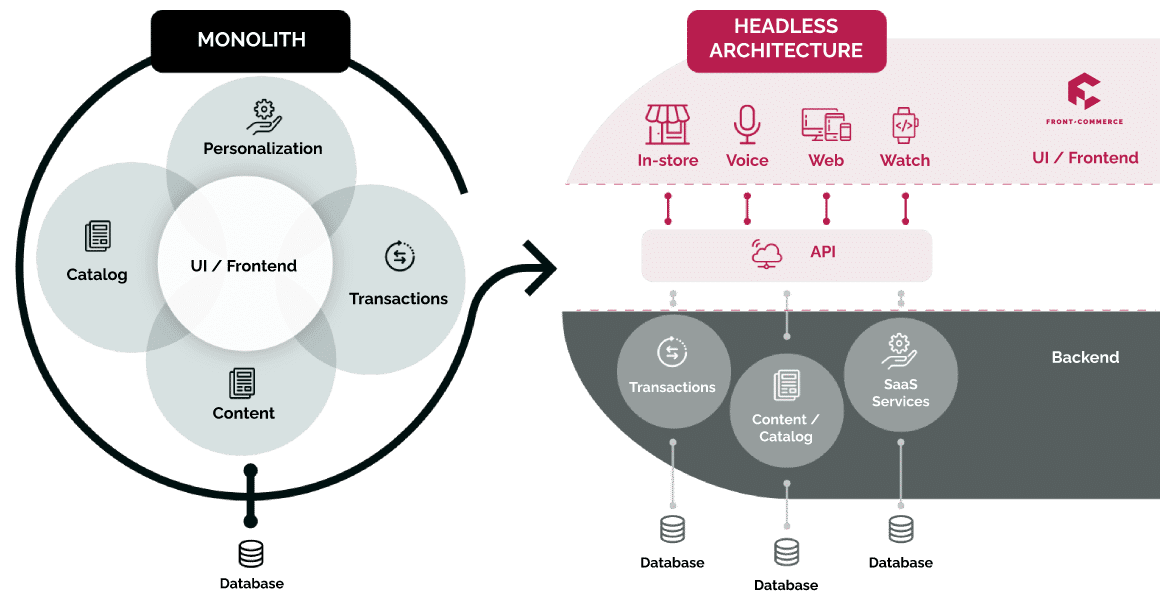Headless Commerce: A Statistical Insight
With the data-driven insights collated below, you can gain a deeper understanding of the transformative power that headless commerce brings to the table, and how it has reshaped e-commerce today.
From market penetration and revenue growth to customer satisfaction and omnichannel capabilities, the numbers will guide you through the paradigm shift that headless commerce brings.
What is headless commerce?
In short, Headless commerce is an architectural approach in e-commerce where the front-end (the part we see, so, typically the website or user interface) is decoupled from the back-end functionality (the bit we don’t see that makes everything work such as inventory management, payment processing, and order fulfilment). Unlike traditional e-commerce platforms, which tightly integrate the front-end and back-end systems, the headless approach gives a business unmatched flexibility:
- The front-end presentation layer communicates with the back-end through APIs, empowering a brand to create a storefront that’s tailored to theirs and their customers’ needs.
“The global headless commerce market was valued at USD 1.32 billion in 2020 and is projected to reach USD 13.08 billion by 2028.” – Grand View Research
- A headless architecture also enables businesses to adopt a composable approach, integrating third-party services and technologies such as AI-driven personalization or search services, the CMS of their choosing or best-of-breed payment solutions.
Headless Commerce Statistics in 2023
- 62% of companies agree that headless eCommerce can significantly increase engagement and conversions. Yotta
- 92% of businesses think it’s easier to deliver a powerful digital experience with headless commerce platforms. WPengine
- 68% of companies that want to go headless would use the services of headless eCommerce platforms. WPengine
- 61% of retailers from one survey said they’d either implemented headless commerce or planned to. Yotta
- 92% of the respondents believe that headless technology helped in better customers’ experience. WPengine
- 64% of enterprises are already using a headless architecture,a distinct 25% increase from 2019. Vanson Bourne
- The global headless commerce market was valued at USD 1.32 billion in 2020 and is projected to reach USD 13.08 billion by 2028, growing at a compound annual growth rate (CAGR) of 30.1% during the forecast period. Grand View Research
- In 2020 57% of retailers were either already using or considering adopting a headless commerce architecture. CommerceNext and Emarsys
- Brands using headless commerce platforms experienced a 25% increase in their conversion rates. Gartner (2019)
- Companies implementing headless commerce experienced a 50% decrease in their time to market for new digital experiences. Contentful
- The Headless CMS market is predicted to touch USD 3.8 billion in 2032. Experro
- 54% of firms that use APIs report greater productivity. Mulesoft
Example of a headless commerce architecture, compared with a monolithic e-commerce architecture

Adopt a headless commerce approach
So, as you’ve realised from all of the above statistics, headless commerce is an important step if you want to stay at the top of your e-commerce game. And ultimately, it will drive growth, customer loyalty, and competitive advantage.
Adopting a headless approach offers your business the freedom to innovate and evolve, or even create, your digital sales strategy, adapt quickly to new trends, and provide personalized, engaging customer experiences across multiple channels.
Learn more about headless commerce by browsing our dedicated content: headless commerce platforms, migration strategies, real use cases, and more …


